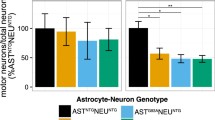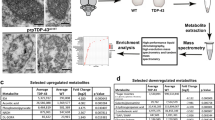Abstract
Glutamate-induced excitotoxicity is considered as one of the major pathophysiological factors of motoneuron death in amyotrophic lateral sclerosis and other motoneuron diseases. In order to expand our knowledge on mechanisms of glutamate-induced excitotoxicity, the present study proposes to determine the metabolic consequences of glutamate and astrocytes in primary enriched motoneuron culture. Using liquid chromatography coupled to high-resolution mass spectrometry (LC-HRMS), we showed that the presence of astrocytes and glutamate profoundly modified the metabolic profile of motoneurons. Our study highlights for the first time that crosstalk between astrocytes and enriched motoneuron culture induced alterations in phenylalanine, tryptophan, purine, arginine, proline, aspartate, and glutamate metabolism in motoneurons. We observed that astrocytes modulate the sensitivity of motoneurons to glutamate, since metabolites altered by glutamate in motoneurons cultured alone were different (except 5-hydroxylysine) from those altered in co-cultured motoneurons. Our findings provide new insight into the metabolic alterations associated to astrocytes and glutamate in motoneurons and provide opportunities to identify novel therapeutic targets.



Similar content being viewed by others
References
Dong X-x, Wang Y, Qin Z-h (2009) Molecular mechanisms of excitotoxicity and their relevance to pathogenesis of neurodegenerative diseases. Acta Pharmacol Sin 30(4):379–387
King AE, Woodhouse A, Kirkcaldie MTK, Vickers JC (2016) Excitotoxicity in ALS: Overstimulation, or overreaction? Exp Neurol 275(Part 1):162–171. https://doi.org/10.1016/j.expneurol.2015.09.019
Blasco H, Mavel S, Corcia P, Gordon PH (2014) The glutamate hypothesis in ALS: pathophysiology and drug development. Curr Med Chem 21(31):3551–3575. https://doi.org/10.2174/0929867321666140916120118
Heath PR, Shaw PJ (2002) Update on the glutamatergic neurotransmitter system and the role of excitotoxicity in amyotrophic lateral sclerosis. Muscle Nerve 26(4):438–458. https://doi.org/10.1002/mus.10186
Van Den Bosch L, Vandenberghe W, Klaassen H, Van Houtte E, Robberecht W (2000) Ca2+-permeable AMPA receptors and selective vulnerability of motor neurons. J Neurol Sci 180(1–2):29–34. https://doi.org/10.1016/S0022-510X(00)00414-7
Madji Hounoum B, Vourc'h P, Felix R, Corcia P, Patin F, Gueguinou M, Potier-Cartereau M, Vandier C et al (2016) NSC-34 motor neuron-like cells are unsuitable as experimental model for glutamate-mediated excitotoxicity. Front Cell Neurosci 10:118. https://doi.org/10.3389/fncel.2016.00118
Grosskreutz J, Van Den Bosch L, Keller BU (2010) Calcium dysregulation in amyotrophic lateral sclerosis. Cell Calcium 47(2):165–174. https://doi.org/10.1016/j.ceca.2009.12.002
Lehre KP, Levy LM, Ottersen OP, Storm-Mathisen J, Danbolt NC (1995) Differential expression of two glial glutamate transporters in the rat brain: quantitative and immunocytochemical observations. J Neurosci 15(3 Pt 1):1835–1853
Rothstein JD, Tsai G, Kuncl RW, Clawson L, Cornblath DR, Drachman DB, Pestronk A, Stauch BL et al (1990) Abnormal excitatory amino acid metabolism in amyotrophic lateral sclerosis. Ann Neurol 28(1):18–25. https://doi.org/10.1002/ana.410280106
Rothstein JD, Van Kammen M, Levey AI, Martin LJ, Kuncl RW (1995) Selective loss of glial glutamate transporter GLT-1 in amyotrophic lateral sclerosis. Ann Neurol 38(1):73–84. https://doi.org/10.1002/ana.410380114
Bendotti C, Tortarolo M, Suchak SK, Calvaresi N, Carvelli L, Bastone A, Rizzi M, Rattray M et al (2001) Transgenic SOD1 G93A mice develop reduced GLT-1 in spinal cord without alterations in cerebrospinal fluid glutamate levels. J Neurochem 79(4):737–746
Madji Hounoum B, Mavel S, Coque E, Patin F, Vourc'h P, Marouillat S, Nadal-Desbarats L, Emond P et al (2017) Wildtype motoneurons, ALS-linked SOD1 mutation and glutamate profoundly modify astrocyte metabolism and lactate shuttling. Glia 65(4):592–605. https://doi.org/10.1002/glia.23114
Raoul C, Estevez AG, Nishimune H, Cleveland DW, deLapeyriere O, Henderson CE, Haase G, Pettmann B (2002) Motoneuron death triggered by a specific pathway downstream of Fas. Potentiation by ALS-linked SOD1 mutations. Neuron 35(6):1067–1083. https://doi.org/10.1016/S0896-6273(02)00905-4
Duong FHT, Warter JM, Poindron P, Passilly P (1999) Effect of the nonpeptide neurotrophic compound SR 57746A on the phenotypic survival of purified mouse motoneurons. Br J Pharmacol 128(7):1385–1392. https://doi.org/10.1038/sj.bjp.0702910
Zhang H, Xing L, Rossoll W, Wichterle H, Singer RH, Bassell GJ (2006) Multiprotein complexes of the survival of motor neuron protein SMN with Gemins traffic to neuronal processes and growth cones of motor neurons. J Neurosci 26(33):8622–8632. https://doi.org/10.1523/jneurosci.3967-05.2006
Wang W, Qi B, Lv H, Wu F, Liu L, Wang W, Wang Q, Hu L et al (2017) A new method of isolating spinal motor neurons from fetal mouse. J Neurosci Methods 288:57–61. https://doi.org/10.1016/j.jneumeth.2017.06.014
Madji Hounoum B, Blasco H, Nadal-Desbarats L, Diémé B, Montigny F, Andres CR, Emond P, Mavel S (2015) Analytical methodology for metabolomics study of adherent mammalian cells using NMR, GC-MS and LC-HRMS. Anal Bioanal Chem 407(29):8861–8872. https://doi.org/10.1007/s00216-015-9047-x
Mavel S, Nadal-Desbarats L, Blasco H, Bonnet-Brilhault F, Barthelemy C, Montigny F, Sarda P, Laumonnier F et al (2013) 1H-13C NMR-based urine metabolic profiling in autism spectrum disorders. Talanta 114:95–102. https://doi.org/10.1016/j.talanta.2013.03.064
Xia J, Wishart DS (2016) Using metaboAnalyst 3.0 for comprehensive metabolomics data analysis. Curr Protoc Bioinformatics 55:14.10.11–14.10.91. https://doi.org/10.1002/cpbi.11
Dong-Ruyl L, Sawada M, Nakano K (1998) Tryptophan and its metabolite, kynurenine, stimulate expression of nerve growth factor in cultured mouse astroglial cells. Neurosci Lett 244(1):17–20. https://doi.org/10.1016/S0304-3940(98)00120-7
Moroni F (1999) Tryptophan metabolism and brain function: Focus on kynurenine and other indole metabolites. Eur J Pharmacol 375(1–3):87–100. https://doi.org/10.1016/S0014-2999(99)00196-X
Dringen R, Gutterer JM, Hirrlinger J (2000) Glutathione metabolism in brain. Metabolic interaction between astrocytes and neurons in the defense against reactive oxygen species. Eur J Biochem 267(16):4912–4916
Prebil M, Jensen J, Zorec R, Kreft M (2011) Astrocytes and energy metabolism. Arch Physiol Biochem 117(2):64–69. https://doi.org/10.3109/13813455.2010.539616
Rothstein JD, Dykes-Hoberg M, Pardo CA, Bristol LA, Jin L, Kuncl RW, Kanai Y, Hediger MA et al (1996) Knockout of glutamate transporters reveals a major role for astroglial transport in excitotoxicity and clearance of glutamate. Neuron 16(3):675–686. https://doi.org/10.1016/S0896-6273(00)80086-0
Maragakis NJ, Rothstein JD (2006) Mechanisms of disease: Astrocytes in neurodegenerative disease. Nat Clin Pract Neurol 2(12):679–689. https://doi.org/10.1038/ncpneuro0355
Araque A, Parpura V, Sanzgiri RP, Haydon PG (1999) Tripartite synapses: Glia, the unacknowledged partner. Trends Neurosci 22(5):208–215. https://doi.org/10.1016/S0166-2236(98)01349-6
Daniels BP, Jujjavarapu H, Durrant DM, Williams JL, Green RR, White JP, Lazear HM, Gale M Jr et al (2017) Regional astrocyte IFN signaling restricts pathogenesis during neurotropic viral infection. J Clin Invest 127(3):843–856. https://doi.org/10.1172/JCI88720
Sako W, Abe T, Izumi Y, Harada M, Kaji R (2016) The ratio of N-acetyl aspartate to glutamate correlates with disease duration of amyotrophic lateral sclerosis. J Clin Neurosci 27:110–113. https://doi.org/10.1016/j.jocn.2015.08.044
Moffett JR, Ross B, Arun P, Madhavarao CN, Namboodiri AMA (2007) N-Acetylaspartate in the CNS: from neurodiagnostics to neurobiology. Prog Neurobiol 81(2):89–131. https://doi.org/10.1016/j.pneurobio.2006.12.003
Baslow MH (2010) Evidence that the tri-cellular metabolism of N-acetylaspartate functions as the brain's "operating system": How NAA metabolism supports meaningful intercellular frequency-encoded communications. Amino Acids 39(5):1139–1145. https://doi.org/10.1007/s00726-010-0656-6
Gerardo-Nava J, Mayorenko II, Grehl T, Steinbusch HW, Weis J, Brook GA (2013) Differential pattern of neuroprotection in lumbar, cervical and thoracic spinal cord segments in an organotypic rat model of glutamate-induced excitotoxicity. J Chem Neuroanat 53:11–17. https://doi.org/10.1016/j.jchemneu.2013.09.007
Do-Ha D, Buskila Y, Ooi L (2017) Impairments in motor neurons, interneurons and astrocytes contribute to Hyperexcitability in ALS: Underlying mechanisms and paths to therapy. Mol Neurobiol. https://doi.org/10.1007/s12035-017-0392-y
Magistretti PJ (2009) Role of glutamate in neuron-glia metabolic coupling. Am J Clin Nutr 90(3):875S–880S. https://doi.org/10.3945/ajcn.2009.27462CC
Pellerin L, Bouzier-Sore AK, Aubert A, Serres S, Merle M, Costalat R, Magistretti PJ (2007) Activity-dependent regulation of energy metabolism by astrocytes: An update. Glia 55(12):1251–1262. https://doi.org/10.1002/glia.20528
Pellerin L, Magistretti PJ (2005) Ampakine CX546 bolsters energetic response of astrocytes: A novel target for cognitive-enhancing drugs acting as alpha-amino-3-hydroxy-5-methyl-4-isoxazolepropionic acid (AMPA) receptor modulators. J Neurochem 92(3):668–677. https://doi.org/10.1111/j.1471-4159.2004.02905.x
Belanger M, Allaman I, Magistretti PJ (2011) Brain energy metabolism: Focus on astrocyte-neuron metabolic cooperation. Cell Metab 14(6):724–738. https://doi.org/10.1016/j.cmet.2011.08.016
Ullian EM, Harris BT, Wu A, Chan JR, Barres BA (2004) Schwann cells and astrocytes induce synapse formation by spinal motor neurons in culture. Mol Cell Neurosci 25(2):241–251. https://doi.org/10.1016/j.mcn.2003.10.011
Arumugam S, Garcera A, Soler RM, Tabares L (2017) Smn-deficiency increases the intrinsic excitability of motoneurons. Front Cell Neurosci 11(269). https://doi.org/10.3389/fncel.2017.00269
Urushitani M, Shimohama S, Kihara T, Sawada H, Akaike A, Ibi M, Inoue R, Kitamura Y et al (1998) Mechanism of selective motor neuronal death after exposure of spinal cord to glutamate: Involvement of glutamate-induced nitric oxide in motor neuron toxicity and nonmotor neuron protection. Ann Neurol 44(5):796–807. https://doi.org/10.1002/ana.410440514
Acknowledgments
We thank the staff of the Programme Pluri-Formation “Analyze des Systèmes Biologiques” (PPF ASB) platform of the University François-Rabelais in Tours, France, Céline Salsac, and Antoine Lefèvre for technical assistance.
Funding
This work was supported by grants from the institut national de la santé et de la recherche médicale (INSERM), the association française pour la recherche sur la SLA (ARSLA), ANR-14-RARE-0006 E-RARE “FasSMALS” and ANR “GliALS”. E.C. received a grant from the association française contre les myopathies (AFM) and B. MH received a grant from “La Région Centre” (2013–10).
Author information
Authors and Affiliations
Contributions
B. MH, H. B, E. C, P. V, P. E, P. C, C. R. A, C. R, and S. M designed of the experiments and wrote the manuscript. H. B and S. M managed the project. B. MH, E. C, C. R, and S. M performed experiments and/or contributed to the interpretation of data.
Corresponding author
Ethics declarations
Conflict of Interest
The authors declare that they have no conflict of interest.
Electronic supplementary material
ESM 1
(DOCX 591 kb)
Rights and permissions
About this article
Cite this article
Madji Hounoum, B., Blasco, H., Coque, E. et al. The Metabolic Disturbances of Motoneurons Exposed to Glutamate. Mol Neurobiol 55, 7669–7676 (2018). https://doi.org/10.1007/s12035-018-0945-8
Received:
Accepted:
Published:
Issue Date:
DOI: https://doi.org/10.1007/s12035-018-0945-8




